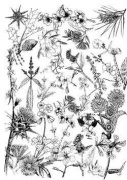Carduus Thistle
Carduus pycnocephalus
There is an aspect within each of us that we recognise as being perfect; it is part of our divine spark or essence. We need to connect to this facet of our being in order to maintain well being. For some of us it is difficult to connect to our perfect state of being, while for others it is seems almost impossible. Without doubt the main reason for our inability to recognise the perfect self within is negative programming occurring during the formative years of childhood. For example, we may have been taught to expect failure, that we are stupid, will
always be poor, not to expect love in our lives, etc. The vast majority of these lessons are karmic in nature: they are patterns of imbalance carried into the present incarnation from previous lives, waiting to be addressed when the soul has sufficient maturity. Those of us who can not connect with the perfect self struggle in life on many different levels. Carduus opens us to the possibility that there is something perfect within us, no matter how small or seemingly insignificant it may appear.
Suggested uses for Carduus Thistle:
- for those who are overly critical of themselves, seeing little good in their thoughts and actions
- for those who lack confidence in their abilities
- for those who become lost in concepts of imperfection, failure, selfdoubt, self-reproach, self-distrust or self-disgust
- for those whose self-criticism hinders their spiritual development.
The purple flower of the Carduus thistle, appearing above the spiny foliage, is a large part of the signature of this plant. The flower resonates with a high frequency within the light body, standing clear and aloof above the intricate blades running down the stem in spiny wing shapes. Carduus amplifies our higher levels of consciousness so that we can look down upon our barbs and barriers, see them from a higher perspective rather than being caught in their tangle of pain.
extract from our book
This spiral bound 87 page book gives full page descriptions of all of the 38 flower oils. The descriptions explore the personality types and universal principles that are associated with the oils and their parallel flower remedies. The impact of each oil upon the subtle anatomy is also described as well as down to earth suggestions on how each essence can be used. This is backed up with a complete cross-referenced Repertory containing 200 headings. There is also information on how to use them, how they are made, the genesis and background to their making, how they differ from essential oils, botanical notes




